Lizards are reptiles! This group of reptilian creatures live across the world in a range of climates and habitats. On every continent except Antarctica, you can find lizards ranging from tiny and docile omnivores to huge and aggressive predators. They also come in an array of colors and appearances, using hues of the rainbow and manifesting with unique scale patterns too. This article explores the great diversity of lizard coloration across our wild planet, breaking down some of the most rare and common lizard colors and sharing examples of each. We will also discuss the key characteristics of animals in the “lizard” category and a few lizards that break the mold! With that in mind, let’s start by learning the basics of lizards. From there, we can dive in to discover some of the most unique colorful lizards living across the earth. Let’s go!
About Lizards
The word “lizard” is used to refer to the diverse assortment of more than 5,000 reptile species. These reptiles are squamate species. Squamata is the largest order of reptiles and includes lizards along with snakes and worm lizards. Lizards are distinguished by some key features. Physically, lizards typically have four legs, a cylindrical body, and a long tail. Across the thousands of lizard species, lizards range from tiny (as small as one inch long in the case of geckos) to gigantic (10-foot-long giant Komodo dragons). Lizards also have moveable eyelids. These features distinguish lizards from snakes. However, there are some species that do not have four well-developed legs (and we will learn about one of those species later in this article!).
Additionally, like other reptiles, lizards are covered in scales. These scales are formed out of keratin (the same protein that makes up human hair and nails). Having scales and leathery, tough skin is part of what allows reptiles to thrive in a variety of harsh environments. Scales cover a lizard’s skin in an overlapping pattern and come in a wide range of patterns and colors.
Pet Lizards
In general, these scaly-skinned creatures prey on insects, birds, and small rodents. Some make great pets. They can be a popular alternative to a cat or a dog since lizards do not have any fur. Some of the unique lizards mentioned in this article are the result of breeding in captivity, while others are only found in specific parts of nature.
There are a few lizards that are venomous and have been known to attack humans. Those might remind you of the dragons of fairytales or dinosaurs of other eras! However, overall, most lizards are omnivores. In fact, their diets vary depending on a lizard’s habitat. This varies a lot, since lizards live around the world on every continent except for Antarctica!
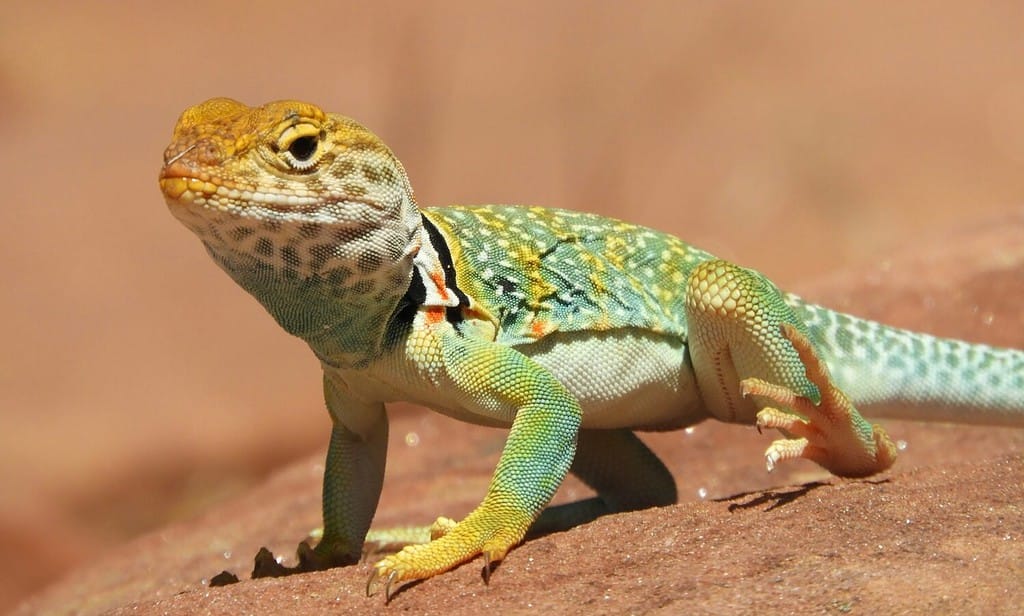
The common collared lizard is one of many bright-colored lizard species in North America.
©PDeluca/Shutterstock.com
Colors of Lizards
Lizards come in a rainbow of colors. Let’s review some of the colors of lizards in our world, starting from the most rare and covering common colors too!
Rare: Blue

The Grand Cayman blue iguana is the largest land animal in the Cayman Islands.
©Kurit afshen/Shutterstock.com
One of the most rare colors for a lizard is blue. One example of a blue lizard is the rare blue iguana (Cyclura lewisi), also known as the Cayman blue iguana for its home in the Cayman Islands. This endangered species only lives on Grand Cayman Island. These blue iguanas typically grow to 20 to 30 inches long and can weigh up to 30 pounds. However, they can get to be much bigger, reaching to over 5 feet long from its head to the tip of its tail! This makes the blue iguana the largest land animal native to the Grand Cayman Island.
A neighbor of the Cayman blue iguana is the Grand Cayman blue-fanned anole, which has blue dewlaps that protrude from the lizard’s blue-green body.
Another blue lizard is the blue racer lizard (Eumeces fasciatus), also known as the five-lined skink. These lizards can grow to be up to 8.5 inches long and have five yellow or white stripes that run from the lizard’s head to tail. These lizards live in North America, crossing a range from as far north as Ontario, Canada to Florida, United States.
Rare: Purple

Male “Spider Man agama” lizards look like they are wearing a Spider Man suit.
©Olha Solodenko/Shutterstock.com
Another rare lizard color is purple! There are not many purple lizard species. One famous purple lizard in the Mwanza flat-headed rock agama (Agama mwanzae), which lives in parts of Africa including Kenya, Tanzania, and Rwanda. Male lizards in this species are also called the “Spider Man agama” for the way its scales make the creatures look like they are wearing a Spider Man suit. These lizards have a unique coloration, with pink-purple heads and bodies and deep blue-purple tails and legs.
One other is the purple-backed spiny lizard (Sceloporus magister). Though this lizard is not truly purple, it does often have blue or purple stripes or spots on their bodies.
Rare: Pink
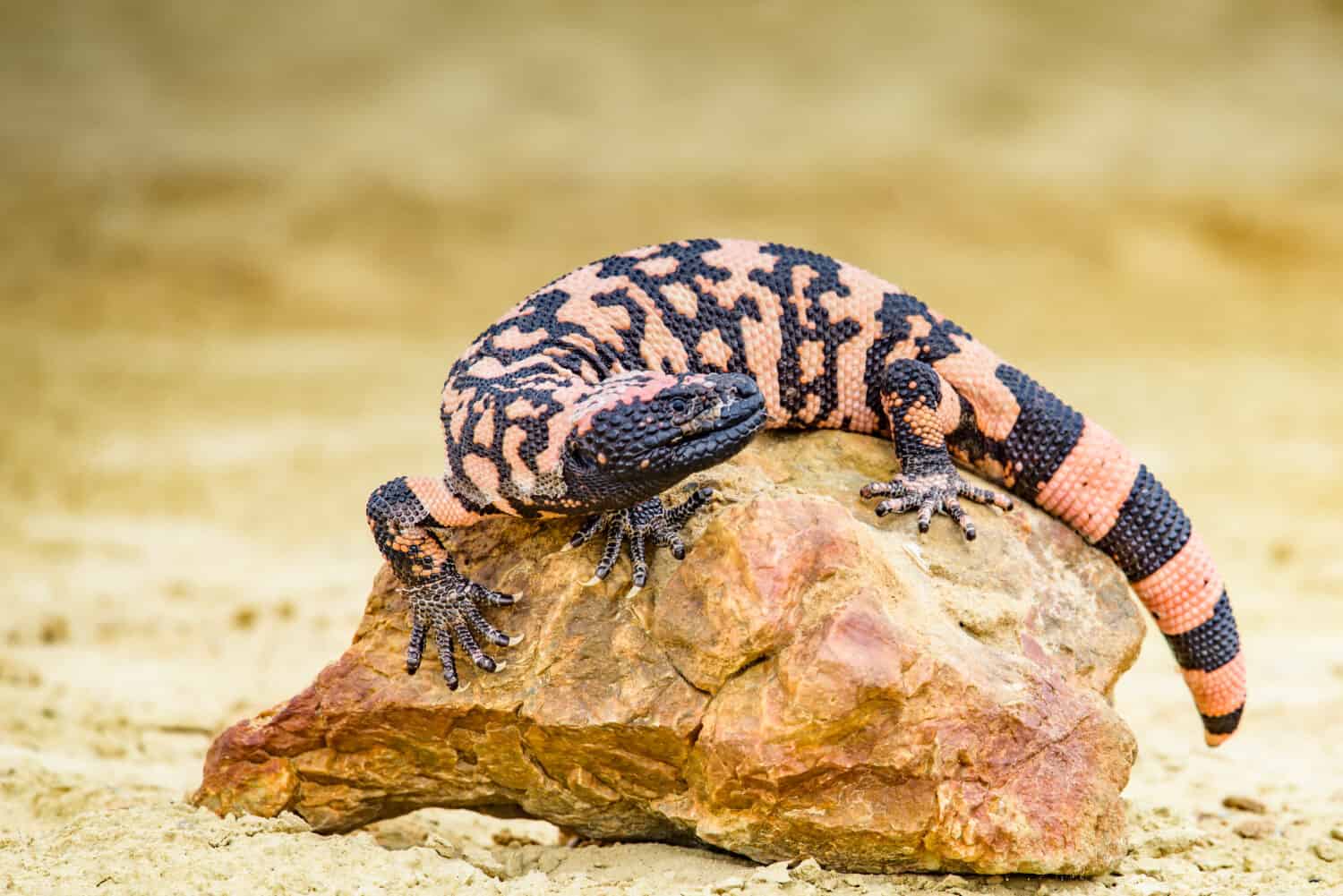
Pink gila monsters live in the desert and can deliver a painful, venomous bite.
©Vaclav Sebek/Shutterstock.com
Few lizards are pink, making this a rare color for lizards! In general, pink is a rare color for reptiles. A few pink lizards include the common house gecko, which lives in Asia, and has a pale pink color. Similarly, the Mediterranean house gecko is a small lizard with pale pink, textured skin with splotches of yellow, brown, and red. Some also include the male Mwanza flat-headed rock agama in the pink category, since the color of its head and thorax can be pink or pink-purple.
On the large side, the Galapagos pink land iguana (Conolphus marthae) looks like something from a different era of history! This rare lizard lives only in Northern Galapagos, where this pale pink creature is sadly an endangered species.
In North America, the famous desert creature the gila monster (Heloderma suspectum) lives in desert habitats and can deliver a painful, venomous bite from strong jaws and sharp teeth. These lizards live in southwestern U.S. states like Arizona and northern Mexico. They have a variety of colors but are often pink in color with dark-colored marks.
One of the most unique pink lizards is the pink blind legless skink (Typhlosaurus vermis). This lizard looks like a worm or a snake and is one of the few lizard species that does not have four legs. The pink blind legless skink lives primarily underground in sandy, moist soils of South Africa. If you see one, you might mistake it for a worm– since it reaches just a few inches long and ranges in color from pale to bright pink.
Rare: Red
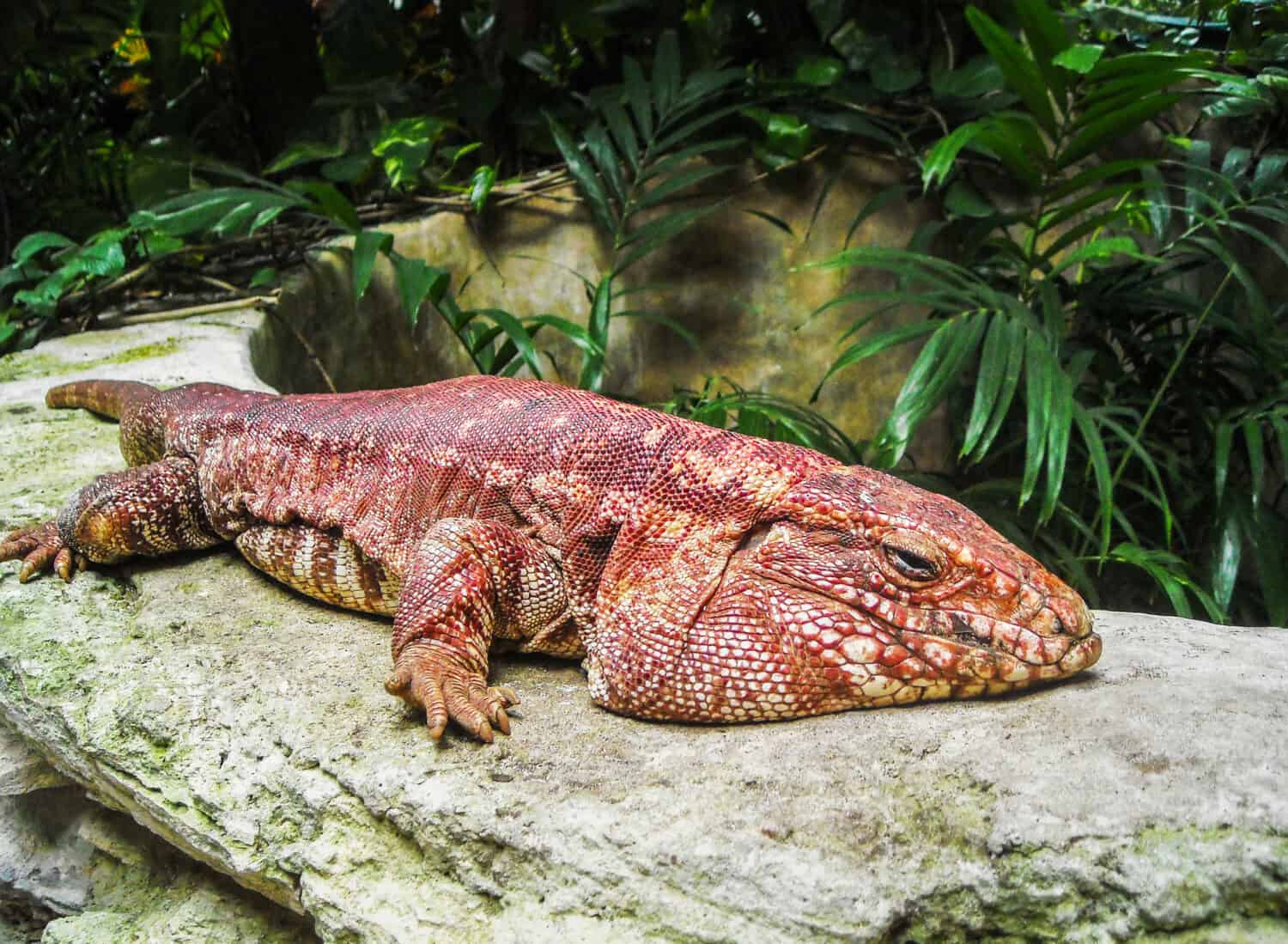
The red tegu can reach a huge size and grow up to five feet long.
©Antonio Rico/Shutterstock.com
Overlapping with the pink lizard category is the group of red-colored lizards. However, red might be a bit more common. However, do not mistake red lizards with their amphibian counterparts, red salamanders. Though red salamanders are plentiful and may be mistaken for lizards, they belong to the amphibian category and do not have a reptile’s scaly skin. Nevertheless, there are still several actual lizards that appear in a range of red colors.
For example, the red tegu (Salvator rufescens) lives in South America, particularly Argentina, and can grow to immense sizes of up to 5 feet long. This makes them among the biggest red lizards.
Rock dragons, which live in India, range in color but often have bright red stripes across their heads and backs.
Some of the most common red lizards are red hypo iguanas. The colors emerge as the iguana grows into adulthood, but can also change colors as they adapt to a new environment.
Another common red lizard is the bearded dragon (Pogona minor minima), which is one of the most popular lizards to keep as a pet. The red-bearded dragon lizard is relatively rare. In fact, entirely red species of bearded dragons are the result of breeding in captivity and cannot be found in the wild.
Relatively Common: Yellow

The leopard gecko (
Eublepharis macularius) is a cathemeral, ground-dwelling lizard naturally found in the highlands of Asia and throughout Afghanistan, to parts of northern India.
©Milan Zygmunt/Shutterstock.com
Moving from rare lizard colors to more common coloration, we have a group of yellow-colored lizards. For example, the yellow-spotted lizard (Lepidophyma flavimaculatum) is a species that has yellow spots covering its brown body. These lizards live in the southwestern part of the United States and nearby Mexico and are among three sub-species of yellow lizards.
Leopard geckos (Eublepharis macularius), which live natively in desert areas in Afghanistan, Iran, Pakistan, and nearby countries, are small lizards with yellow backs and legs covered in black spots that give it a leopard-like appearance.
One dangerous yellowish lizard is the famous komodo dragon (Varanus komodoensis). While these scaly creatures are usually dark brown or black in color, depending on their age and location, they may be more of a yellow-gray color. Komodo dragons are the largest lizards in the world, and can easily weigh up to 300 pounds and reach 10 feet in length. The deadly bite of a komodo dragon can be as potent as the most venomous snake in the world: the taipan of Australia.
Other yellow lizard species include the yellow monitor, the yellow striped tree skink, the Galapagos land iguana, the argus monitor, and others.
Common: Green

The Mexican
alligator
lizard is a rare species said to resemble an alligator.
©Wesley Aston/Shutterstock.com
Green is one of the most common colors for lizards. For example, green anoles (Anolis carolinensis) live plentifully throughout the southeastern part of the United States and typically appear in a bright lime green color, though they have the ability to change color to match the environment.
One unique green lizard species is the Mexican alligator lizard (Abronia graminea). This lizard is said to resemble an alligator, with bright green scales and sharp claws. This endangered species lives only in a small part of the Sierra Madre Oriental mountains, and unfortunately, capturing these lizards as pets has contributed to the species’ decline in the wild.
Another green lizard species is the jeweled gecko (Naultinus gemmeus), which lives in New Zealand. You can find these lizards living in shrubs, on vines, or in trees. They have a bright green color that blends well with the foliage of this habitat.
Other green lizards include the Caiman lizard, green water dragon, jeweled lacerta, and others.
Common: Brown

Brown anoles are native to Cuba and the Bahamas but are invasive throughout many parts of the United States.
©Steve Bower/Shutterstock.com
For example, one common brown lizard is the brown anole (Anolis sagrei, formerly known a Norops sagrei). These lizards grow to be 5 to 9 inches long and have skin that is brown or brownish-gray. The brown anole is native to Cuba and the Bahamas. However, it is prevalent throughout many parts of the U.S. and other islands in the Caribbean, where is is considered to be highly invasive.
A more rare brown lizard is the earless monitor (Lanthanotus borneensis), a creature native to Borneo, an island in Southeast Asia. This species is unique for being the only known living species in the scientific family Lanthanotidae.
Other brown lizards include the brown tree skink, the Asian water monitor, the African plated lizard, the European wall lizard, and many others.
Common: Black
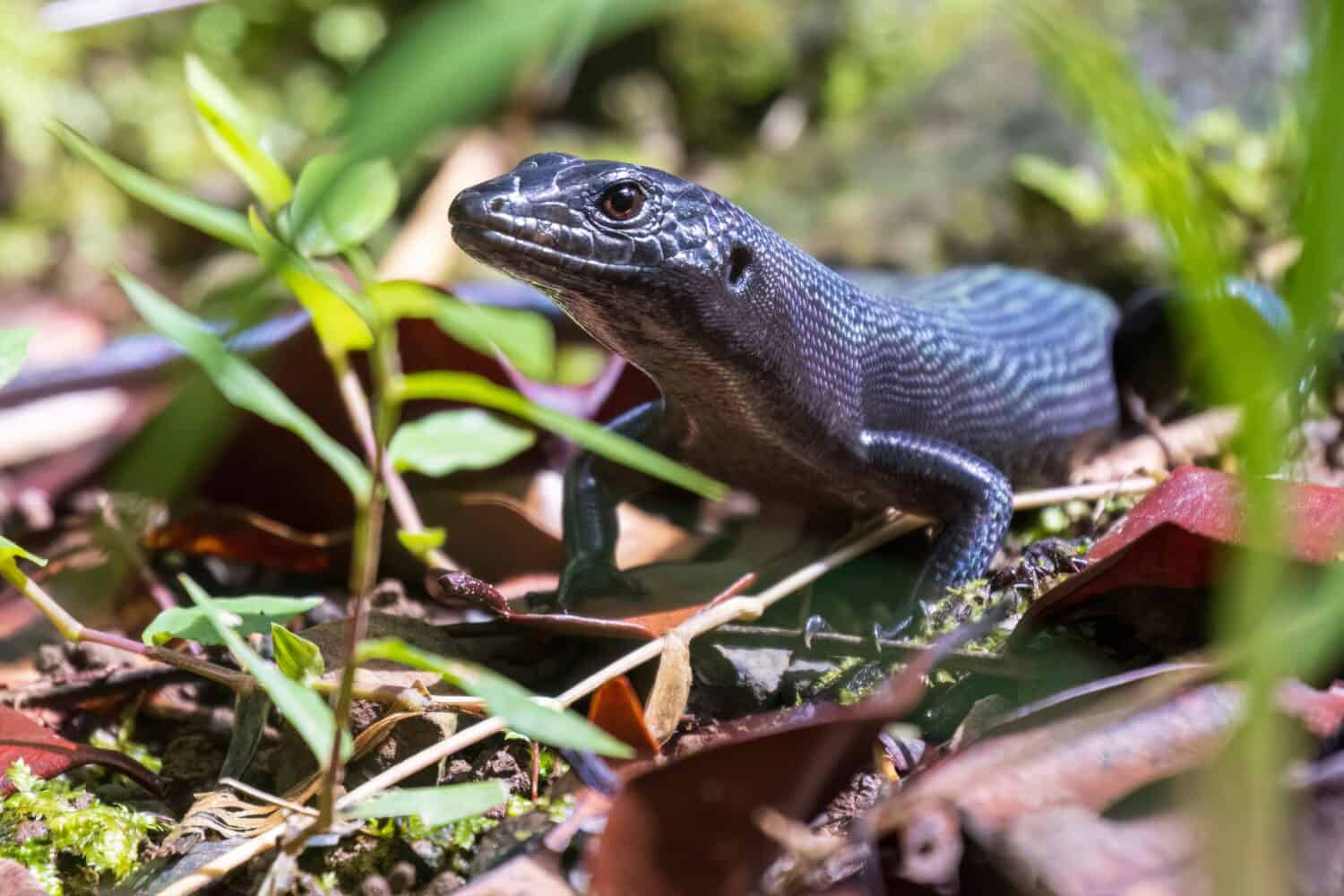
The black emo skink lives in Oceania, including American Samoa and parts of Australia.
©BlueBarronPhoto/Shutterstock.com
Inky black-shaped lizards may be some of the most striking lizards to see. Some of the world’s rarest lizard species are black, making a black lizard sighting an exciting experience.
The black girdled lizard (Cordylus niger) is a black lizard. This several-inch-long species lives in rocky outcroppings in South Africa and is distinguished by its jet black color.
Black rock skinks (Egernia saxatilus) is an Australian lizard species. These lizards are relatively large, reaching 5 to 10 inches long.
The black emo skink (Emoia nigra) inhabits woodland parts of Australia and other parts of Oceania. The black emo skink has inky black coloring and reaches several inches long.
Other black-colored lizards include the lace monitor, king’s skink, roughneck monitor, black tree monitor, and land mullet.
Multi-Colored Lizards

Many lizards, including the striped racer, are multi-colored.
©Sholmes370/Shutterstock.com
As you may have noticed from the list above, many lizard species are not just one color! While there may be a dominant shade defining their body’s coloration, many lizards are multi-colored and have unique coloration that includes stripes, spots, splotches, and other distinct patterns.
Color-Changing Lizards
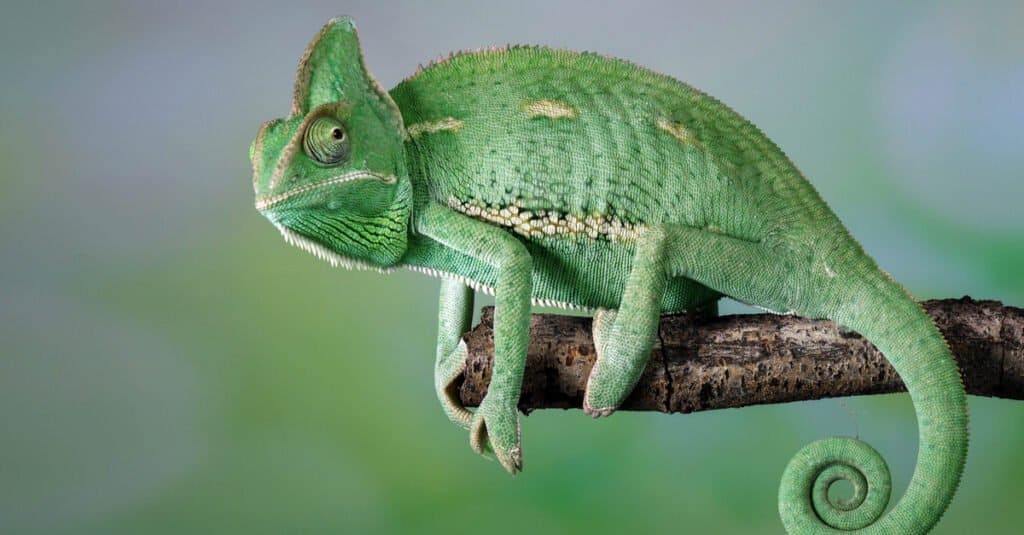
Chameleons are famous for their ability to change color to blend in with their surroundings.
©Lauren Suryanata/Shutterstock.com
In addition to this rainbow of lizards in different colors, some species can even change colors! Think about the famous chameleon, which is known for changing its color from vibrant green to dark brown in order to blend in with either tree leaves or tree bark in its habitat. Another color-changing lizard is the green anole. If you see an anole, it could appear as bright green, brown, or gray.
Why do they change colors? Lizards might change color in response to multiple external factors, including hormonal changes, temperature, humidity, or the presence of a predator.
The photo featured at the top of this post is © reptiles4all/Shutterstock.com
Thank you for reading! Have some feedback for us? Contact the AZ Animals editorial team.






